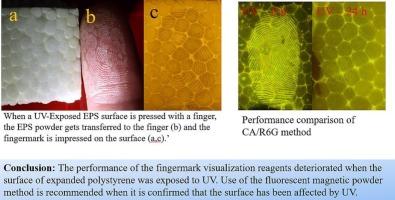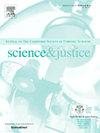Effects of ultraviolet exposure on latent fingermark visualization on expanded polystyrene surfaces
IF 2
4区 医学
Q2 MEDICINE, LEGAL
引用次数: 0
Abstract
It is known that the physical and chemical properties of expanded polystyrene (EPS) surfaces are altered upon exposure to ultraviolet (UV) light; however, the implications for latent fingermark visualization have not been fully explored. In this study, EPS surfaces were exposed to UV light (253.7 nm) either before or after fingermark deposition and subsequently treated with five visualization techniques: Dazzle yellow, cyanoacrylate fuming (CA) followed by fluorescent dye staining, Lumicyano, small particle reagent (SPR), and Nile red. When illuminated with a blue or green forensic light source, photoluminescence was observed exclusively on UV-exposed surfaces, allowing clear differentiation between UV-exposed and unexposed EPS. Experimental results indicated that Nile red produced the highest-quality fingermarks on unexposed EPS surfaces, while Dazzle yellow and Nile red were most effective for UV-exposed surfaces. In contrast, CA followed by rhodamine 6G staining (CA/R6G) and Lumicyano methods exhibited markedly reduced performance on UV-exposed EPS due to photochemically induced surface alterations. These findings highlight the importance of assessing UV exposure prior to fingermark development and suggest appropriate visualization methods based on surface condition.

紫外曝光对聚苯乙烯膨胀表面手印显现的影响
众所周知,膨胀聚苯乙烯(EPS)表面的物理和化学性质在暴露于紫外线(UV)光时发生改变;然而,对潜在手印可视化的影响尚未得到充分的探讨。在本研究中,在手印沉积之前或之后,将EPS表面暴露在紫外线(253.7 nm)下,随后使用五种可视化技术进行处理:炫黄,氰基丙烯酸酯熏烟(CA),荧光染料染色,Lumicyano,小颗粒试剂(SPR)和尼罗红。当用蓝色或绿色法医光源照射时,光致发光仅在暴露在紫外线下的表面上观察到,从而明确区分暴露在紫外线下和未暴露的EPS。实验结果表明,尼罗红在未暴露的EPS表面上产生的手印质量最高,而眩黄和尼罗红在紫外线暴露的表面上产生的手印质量最高。相比之下,CA之后的罗丹明6G染色(CA/R6G)和Lumicyano方法由于光化学诱导的表面改变,在紫外线暴露的EPS上表现出明显降低的性能。这些发现强调了在手印形成之前评估紫外线暴露的重要性,并提出了基于表面状况的适当可视化方法。
本文章由计算机程序翻译,如有差异,请以英文原文为准。
求助全文
约1分钟内获得全文
求助全文
来源期刊

Science & Justice
医学-病理学
CiteScore
4.20
自引率
15.80%
发文量
98
审稿时长
81 days
期刊介绍:
Science & Justice provides a forum to promote communication and publication of original articles, reviews and correspondence on subjects that spark debates within the Forensic Science Community and the criminal justice sector. The journal provides a medium whereby all aspects of applying science to legal proceedings can be debated and progressed. Science & Justice is published six times a year, and will be of interest primarily to practising forensic scientists and their colleagues in related fields. It is chiefly concerned with the publication of formal scientific papers, in keeping with its international learned status, but will not accept any article describing experimentation on animals which does not meet strict ethical standards.
Promote communication and informed debate within the Forensic Science Community and the criminal justice sector.
To promote the publication of learned and original research findings from all areas of the forensic sciences and by so doing to advance the profession.
To promote the publication of case based material by way of case reviews.
To promote the publication of conference proceedings which are of interest to the forensic science community.
To provide a medium whereby all aspects of applying science to legal proceedings can be debated and progressed.
To appeal to all those with an interest in the forensic sciences.
 求助内容:
求助内容: 应助结果提醒方式:
应助结果提醒方式:


